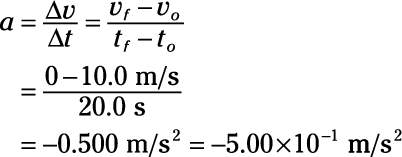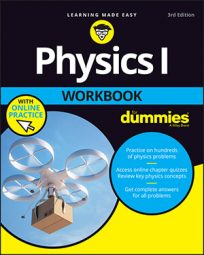You know that you can relate velocity with displacement and time. And you know that you can relate velocity and time to get acceleration. You also can relate displacement with acceleration and time:
If you don’t start off at zero velocity, you use this equation:
Sample question
-
You climb into your drag racer, waving nonchalantly at the cheering crowd. You look down the quarter-mile track, and suddenly the flag goes down. You’re off, getting a tremendous kick from behind as the car accelerates quickly. A brief 5.5 seconds later, you pass the end of the course and pop the chute.
You know the distance you went: 0.25 miles, or about 402 meters. And you know the time it took: 5.5seconds. So just how hard was the kick you got — the acceleration — when you blasted down the track?
26.6 m/s2
-
You know

You can rearrange this equation with a little algebra (just divide both sides by t2 and multiply by 2) to get

-
Plugging in the numbers, you get

What’s 26.6 meters/second2 in more understandable terms? The acceleration due to gravity, g, is 9.8 meters/second2, so this is about 2.7g. And that’s quite a kick.
-
Practice questions
-
The light turns green, and you accelerate at 10.0 m/s2. After 5.00 seconds, how far have you traveled?
-
A stone drops under the influence of gravity, 9.8 m/s2. How far does it drop in 1.2 seconds?
-
A car is going 60.0 miles per hour and accelerating at 10.0 miles per hour2. How far does it go in 1.0 hour?
-
A motorcycle is going 60 miles per hour, and accelerating at -60 miles per hour2. How far does it go in 1 hour?
-
An eagle starts at a speed of 50.0 m/s and, accelerating at -10.0 m/s2, comes to rest on a peak 5.00 seconds later. How far is the peak from the eagle’s original position?
-
A trailer breaks loose from its truck on a steep incline. If the truck was moving uphill at 20.0 m/s when the trailer broke loose, and the trailer accelerates down the hill at 10.0 m/s2, how far downhill does the trailer go after 10.0 seconds?
-
A block of wood is shooting down a track at 10.0 m/s and is slowing down because of friction. If it comes to rest in 20.0 seconds, what is its acceleration, in meters per second2?
-
A minivan puts on the brakes and comes to a stop in 3.0 seconds. If the acceleration is 4.0 m/s2, how far does the minivan travel, in meters, before stopping?
Following are answers to the practice questions:
-
125 meters
-
You want to relate distance to acceleration and time, so use this equation:

-
Plug in the numbers:

-
-
–7.06 meters (that’s 7.06 meters downward)
-
To relate distance to acceleration and time, you use this equation:

-
Substitute the numbers:

-
-
65 miles
-
To relate distance to speed, acceleration, and time, you use this equation:

-
Plug in the numbers:

-
-
30 miles
-
You want to relate distance to speed, acceleration, and time, so you use this equation:

-
Plug in the numbers:

-
-
125 meters
-
To connect distance with speed, acceleration, and time, you use this equation:

-
Plug in the numbers:

-
-
–300 meters (300 m down the hill)
-
To relate acceleration to speed and time, use this equation:

-
Plug in the numbers:

-
-
–5.00 x 10–1 m/s2
-
To relate acceleration to speed and time, use this equation:

-
Plug in the numbers:

-
-
18 meters
-
To relate acceleration to velocity and time, use this equation:

-
Solve for v0:

-
Plug in the numbers:

-

